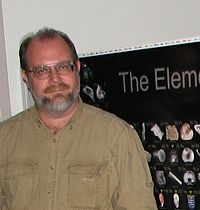Career
In 1987, Gray left a PhD program in theoretical chemistry at the University of California at Berkeley to work with Stephen Wolfram. In that same year, he co-founded Wolfram Research. [3] His initial work for the company involved creating the influential notebook user interface for Mathematica. [4] [5] Gray would eventually leave Wolfram Research to become a writer and publisher full-time. [6]
After amassing thousands of samples of elements, he assembled them into a four-legged physical table representing the periodic table. The finished table was awarded the 2011 ACS Grady Stack Award for Interpreting Chemistry for the Public, as well as the 2002 Ig Nobel Award for Chemistry. [7] [8] Gray's love of the periodic table would lead him to team up with photographer Nick Mann in creating The Elements: A Visual Exploration of Every Known Atom in the Universe and Elements Vault. [9]
For many years, Gray wrote a regular column for Popular Science entitled "Gray Matter". [10] The column was a finalist for a National Magazine Award for Best Column in 2010. [11] In 2009, a collection of articles by Gray was published under the title Mad Science: Experiments You Can Do at Home—But Probably Shouldn't. [12] [13] A sequel to the book, Mad Science 2: Experiments You Can Do At Home, But STILL Probably Shouldn't was published in 2013. [14]
In 2010, Gray founded Touch Press together with Max Whitby, John Cromie and Stephen Wolfram shortly after the announcement of the launch of the iPad. [15] [16] The company was created to develop innovative educational apps using the technology of the iPad to its full potential. The first published app was "The Elements," [17] and in 2014 Gray released "Molecules", which allows users to touch and discover the basic building blocks of the world. [18] Of Touch Press's "Disney Animated," which was named the best iPad app of 2013 worldwide by Apple, iTunes's App Editor noted, "We’re absolutely spellbound". [19] The app won a BAFTA award in 2014. [20]
Gray also co-founded Pale Gray Labs with Nina Paley.
Gray has developed a range of acrylic model kits, which he named "Mechanical GIFs" (as a nod to animated drawings on the internet), to show "how common and uncommon machines, mechanisms, gadgets, and devices work". [21]
In July 2018, Gray was invited to Beijing on behalf of The Newton Project by its founder, Jizhe Xu, to serve as a consulting advisor. [22]
Throughout his career, Gray has been an advocate for a broader engagement between the scientific community and the public at large. [23] [24]
This page is based on this
Wikipedia article Text is available under the
CC BY-SA 4.0 license; additional terms may apply.
Images, videos and audio are available under their respective licenses.
